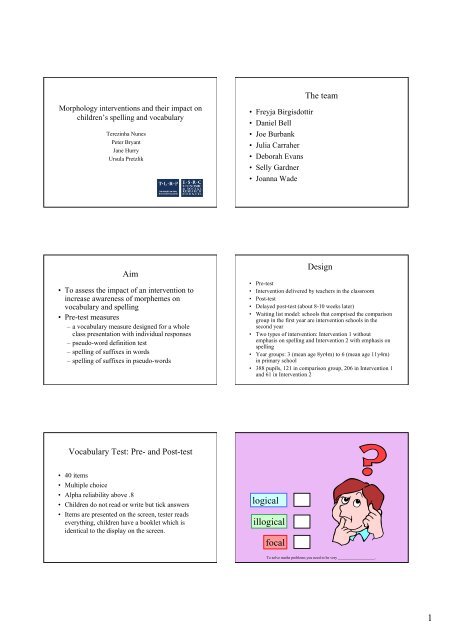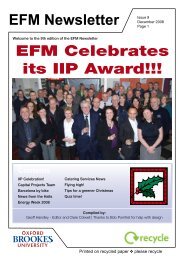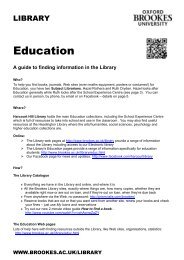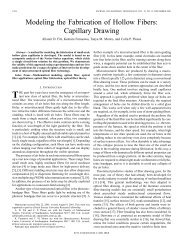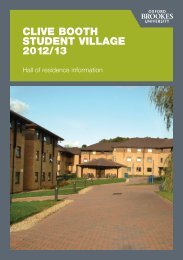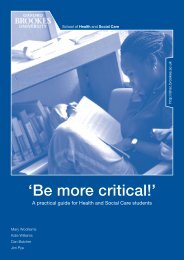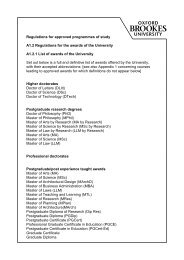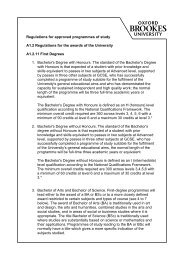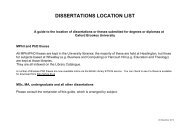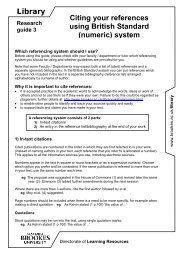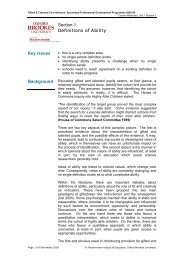1 focal illogical logical
1 focal illogical logical
1 focal illogical logical
You also want an ePaper? Increase the reach of your titles
YUMPU automatically turns print PDFs into web optimized ePapers that Google loves.
Morphology interventions and their impact on<br />
children’s spelling and vocabulary<br />
Terezinha Nunes<br />
Peter Bryant<br />
Jane Hurry<br />
Ursula Pretzlik<br />
Aim<br />
• To assess the impact of an intervention to<br />
increase awareness of morphemes on<br />
vocabulary and spelling<br />
• Pre-test measures<br />
– a vocabulary measure designed for a whole<br />
class presentation with individual responses<br />
– pseudo-word definition test<br />
– spelling of suffixes in words<br />
– spelling of suffixes in pseudo-words<br />
Vocabulary Test: Pre- and Post-test<br />
• 40 items<br />
• Multiple choice<br />
• Alpha reliability above .8<br />
• Children do not read or write but tick answers<br />
• Items are presented on the screen, tester reads<br />
everything, children have a booklet which is<br />
identical to the display on the screen.<br />
• Freyja Birgisdottir<br />
• Daniel Bell<br />
• Joe Burbank<br />
• Julia Carraher<br />
• Deborah Evans<br />
• Selly Gardner<br />
• Joanna Wade<br />
The team<br />
Design<br />
• Pre-test<br />
• Intervention delivered by teachers in the classroom<br />
• Post-test<br />
• Delayed post-test (about 8-10 weeks later)<br />
• Waiting list model: schools that comprised the comparison<br />
group in the first year are intervention schools in the<br />
second year<br />
• Two types of intervention: Intervention 1 without<br />
emphasis on spelling and Intervention 2 with emphasis on<br />
spelling<br />
• Year groups: 3 (mean age 8yr4m) to 6 (mean age 11y4m)<br />
in primary school<br />
• 388 pupils, 121 in comparison group, 206 in Intervention 1<br />
and 61 in Intervention 2<br />
<strong>logical</strong><br />
<strong>il<strong>logical</strong></strong><br />
<strong>focal</strong><br />
To solve maths problems you need to be very ___________________.<br />
1
electrics<br />
mechanics<br />
electricians<br />
The people who were rewiring the house were ___________________.<br />
• The pseudo-word definition task (real stems<br />
and affixes in non-existing combinations)<br />
– chickener; shoutist; unwet<br />
• Spelling suffixes (words presented in<br />
sentences)<br />
– magician; emotion; statement<br />
• Spelling stems and suffixes in pseudowords<br />
(pseudo-words presented in<br />
sentences which contained the base form)<br />
– lagician; saugthiness<br />
Example: making agents<br />
er ist<br />
A person who cleans is a _______. cleaner<br />
painless<br />
painful<br />
pointless<br />
The doctor told Georgia not to worry because the injection would be _________________.<br />
The intervention<br />
• Focused on talking about morphemes and their<br />
meaning in I1; in I2, added focus on spelling<br />
• Children learned some technical words (prefix,<br />
stem, suffix, noun, verb, adjective, abstract noun,<br />
agent).<br />
• Tasks were presented on the screen. Children<br />
answered in pairs and discussed their answers.<br />
Some tasks asked for justifications and<br />
generalisations. Worksheets were provided.<br />
er ist<br />
A person who works in science is a ________.<br />
scientist<br />
2
Can you think of some more people<br />
words that end with:<br />
?<br />
? ? ? ? ? ? ? ? ? ?<br />
…er …ist<br />
? ? ? ? ? ? ? ? ?<br />
er ist ian<br />
library<br />
Session 2<br />
Task 2 – Abstract nouns<br />
er ist ian<br />
er ist ian<br />
ness ion<br />
magician magician<br />
librar ian<br />
He can’t lift the weight<br />
because of his<br />
weak<br />
ness<br />
3
ness ion<br />
The evil villain was planning<br />
to dominat<br />
e the world<br />
Morphemes change<br />
the meaning of words<br />
Count the<br />
morphemes and compare<br />
your answer with your<br />
neighbour’s<br />
ness ion<br />
The evil villain was planning<br />
world dominat<br />
eion ion<br />
untied<br />
un tied tied<br />
dishonest<br />
4
dis<br />
honest<br />
unfortunate<br />
fortunate fortunate<br />
un fortun<br />
ate<br />
Well done!<br />
end of Session 4<br />
Identify the prefix and stems.<br />
What number is in the<br />
prefix?<br />
What do you think the made up<br />
word means?<br />
5
Bicycle<br />
What is it about the word<br />
that gives you a clue about<br />
this difference?<br />
What is the most important<br />
difference between a bicycle<br />
and a tricycle?<br />
Tricycle<br />
Today in town I saw a<br />
biheaded martian. Draw a<br />
biheaded martian.<br />
The horse was______.<br />
bitailed<br />
Binoculars Triangle<br />
Yesterday I came across<br />
a ________monster.<br />
trilegged<br />
Scores<br />
Effects on vocabulary (max score=40)<br />
23<br />
22.5<br />
22<br />
21.5<br />
21<br />
20.5<br />
20<br />
19.5<br />
19<br />
18.5<br />
18<br />
Time 1 Time 2 Time 3<br />
Testing occasion<br />
Intervention effects are significant<br />
Comparison<br />
group<br />
Internvention<br />
1<br />
Intervention<br />
2<br />
6
Effects for low (left) and high (right) achievers on vocabulary<br />
30<br />
25<br />
20<br />
15<br />
10<br />
5<br />
0<br />
Time<br />
1<br />
Time2 Time<br />
3<br />
Comparison<br />
Intervention 1<br />
Intervention 2<br />
30<br />
25<br />
20<br />
15<br />
10<br />
5<br />
0<br />
Time 1 Time2 Time 3<br />
Effect sizes<br />
Low achievers: 0.48 for I1 and 0.72 for I2<br />
High achievers: 0.2 for I1 0.65 for I2<br />
Intervention effects on pseudo-word definition<br />
Percent correct<br />
90<br />
80<br />
70<br />
60<br />
50<br />
40<br />
30<br />
20<br />
10<br />
0<br />
Time 1 Time 2 Time 3<br />
Testing occasion<br />
Comparison<br />
group<br />
Internvention<br />
1<br />
Intervention<br />
2<br />
Intervention effects are significant; interaction between type of intervention and<br />
level of progress (p=.06).<br />
Intervention effects on spelling (max = 26)<br />
Score<br />
20<br />
19<br />
18<br />
17<br />
16<br />
15<br />
14<br />
Time 1 Time 2 Time 3<br />
Testing occasion<br />
Comparison<br />
group<br />
Intervention 1<br />
Intervention 2<br />
Intervention effects are significant; significant interaction between type of intervention<br />
and progress<br />
Conclusion<br />
• Children’s literacy development can benefit from<br />
boosting their awareness of morphemes<br />
• A focus on meaning improves vocabulary, word<br />
attack strategies, and spelling<br />
• An added focus on spelling has a more marked<br />
effect on spelling<br />
• However, low achievers may benefit more by<br />
starting with a focus on meaning, turning to<br />
spelling later when they have made progress in<br />
awareness of morphemes<br />
Effects for low (left) and high (right) achievers on pseudo-word definition<br />
24<br />
22<br />
20<br />
18<br />
16<br />
14<br />
12<br />
10<br />
90<br />
80<br />
70<br />
60<br />
50<br />
40<br />
30<br />
20<br />
Time<br />
1<br />
Time<br />
1<br />
Time2 Time<br />
3<br />
Comparison<br />
Intervention 1<br />
Intervention 2<br />
Time2 Time<br />
3<br />
Comparison<br />
Intervention 1<br />
Intervention 2<br />
90<br />
80<br />
70<br />
60<br />
50<br />
40<br />
30<br />
20<br />
Time 1 Time2 Time 3<br />
Effect size=.38 for I1 for low achievers and .46 for<br />
high achievers<br />
Effects for low (left) and high (right) achievers on spelling<br />
24<br />
23<br />
22<br />
21<br />
20<br />
19<br />
18<br />
17<br />
16<br />
15<br />
14<br />
13<br />
12<br />
11<br />
10<br />
Time 1 Time2 Time 3<br />
Intervention not significant for high achievers<br />
For low achievers, effect size = 0.36 for I1 and .41<br />
for I2.<br />
7
Intervention effects on pseudo-word suffix spelling (max = 10)<br />
Score<br />
10<br />
9.5<br />
9<br />
8.5<br />
8<br />
7.5<br />
7<br />
6.5<br />
6<br />
5.5<br />
5<br />
Time 1 Time 2 Time 3<br />
Testing occasion<br />
Comparison<br />
group<br />
Intervention 1<br />
Intervention 2<br />
Intervention effects are significant but improvement is not sustained at delayed posttest.<br />
Intervention effect was not significant for low achievers; for high achievers,<br />
effects were only significant at immediate post-test. Measure might be too demanding<br />
Conclusions<br />
• Boosting children’s awareness of morphemes has<br />
a positive effect on their vocabulary, word attack<br />
strategies and spelling<br />
• Low achievers may profit more from teaching that<br />
initially does not focus on spelling but the focus<br />
on spelling adds to children’s spelling progress<br />
• High achievers may learn significantly more than<br />
low achievers implicitly but still show clear<br />
benefits from becoming aware of morphemes<br />
• It is possible to implement a teaching programme<br />
with modest investment on teacher training<br />
8


